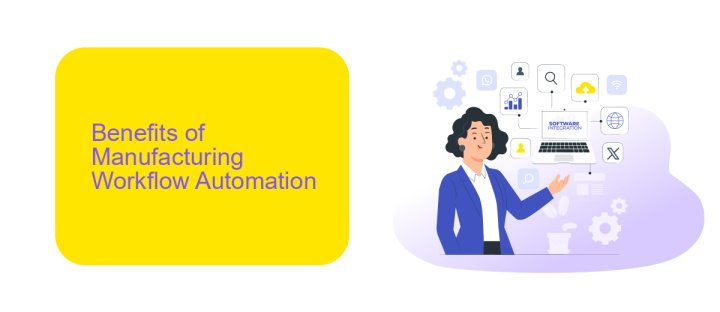Manufacturing Workflow Automation
In today's fast-paced industrial landscape, the need for efficiency and precision is paramount. Manufacturing workflow automation stands at the forefront of this evolution, streamlining processes, reducing human error, and enhancing productivity. By integrating advanced technologies such as robotics, AI, and IoT, manufacturers can achieve unprecedented levels of operational excellence, driving innovation and maintaining a competitive edge in the global market.
Introduction
Manufacturing workflow automation is a transformative approach that enhances efficiency, reduces errors, and streamlines processes in the production environment. By leveraging advanced technologies, manufacturers can automate repetitive tasks, optimize resource allocation, and ensure consistent product quality. This not only boosts productivity but also significantly cuts down operational costs.
- Reduction in manual labor
- Improved accuracy and consistency
- Enhanced scalability and flexibility
- Real-time monitoring and analytics
- Integration with existing systems
One crucial aspect of successful workflow automation is the seamless integration of various software and hardware systems. Services like ApiX-Drive facilitate this by offering robust integration solutions that connect disparate systems, enabling smooth data flow and communication. By utilizing such tools, manufacturers can achieve a cohesive and efficient automated workflow, ultimately leading to improved operational performance and competitiveness in the market.
Benefits of Manufacturing Workflow Automation

Manufacturing workflow automation significantly enhances efficiency by streamlining repetitive tasks and reducing human error. Automated systems can handle complex processes with precision, ensuring consistent product quality and faster production times. This not only boosts productivity but also allows employees to focus on more strategic, value-added activities, driving innovation and continuous improvement within the organization.
Moreover, integrating automation tools with existing systems can provide real-time data analytics and insights, enabling better decision-making and proactive maintenance. Services like ApiX-Drive facilitate seamless integration between various software applications, allowing manufacturers to automate workflows without extensive coding knowledge. This integration capability ensures that data flows smoothly across different platforms, enhancing overall operational efficiency and responsiveness to market demands.
Key Considerations for Implementing Manufacturing Workflow Automation

Implementing manufacturing workflow automation requires careful planning and consideration of several key factors to ensure success. By addressing these factors, organizations can streamline operations, reduce errors, and enhance productivity.
- Assess Current Processes: Begin by analyzing existing workflows to identify bottlenecks and areas for improvement. Understanding the current state is crucial for effective automation.
- Select the Right Tools: Choose automation tools that align with your specific needs. Platforms like ApiX-Drive can facilitate seamless integration between various systems, enhancing data flow and connectivity.
- Employee Training: Ensure that your workforce is adequately trained to work with new automated systems. This includes both technical training and understanding the benefits of automation.
- Scalability: Consider the scalability of the automation solutions. The tools and processes should be able to grow with your business without requiring significant overhauls.
- Continuous Improvement: Automation is not a one-time setup. Regularly review and refine automated processes to adapt to changing needs and technologies.
By focusing on these considerations, manufacturers can effectively implement workflow automation, leading to enhanced operational efficiency and long-term success.
Case Studies and Success Stories

Many companies have successfully implemented manufacturing workflow automation to streamline their operations and boost productivity. One notable example is a mid-sized electronics manufacturer that integrated ApiX-Drive to automate data transfer between their ERP and CRM systems. This integration reduced manual data entry errors and improved data accuracy across departments.
Another success story comes from a large automotive parts supplier that faced challenges with inventory management. By automating their workflow, they achieved real-time inventory tracking and significantly reduced stock discrepancies. The implementation of ApiX-Drive allowed seamless communication between their inventory management software and other business applications.
- Electronics manufacturer: Improved data accuracy and reduced manual errors with ApiX-Drive.
- Automotive parts supplier: Achieved real-time inventory tracking and reduced stock discrepancies.
- Textile company: Enhanced production scheduling and minimized downtime.
These case studies demonstrate the transformative power of manufacturing workflow automation. By leveraging tools like ApiX-Drive, businesses can integrate various systems efficiently, leading to increased productivity and operational excellence. The success stories highlight the diverse applications and significant benefits of adopting automation in different manufacturing sectors.
Future Trends and Outlook
The future of manufacturing workflow automation is poised for significant advancements, driven by the integration of artificial intelligence (AI) and machine learning (ML). These technologies will enable more predictive maintenance, optimize supply chain management, and enhance quality control processes. Additionally, the rise of the Industrial Internet of Things (IIoT) will facilitate real-time data collection and analysis, leading to smarter decision-making and increased operational efficiency.
Moreover, the trend towards cloud-based solutions will continue to grow, offering scalable and flexible automation options. Services like ApiX-Drive will play a crucial role in this evolution by providing seamless integration capabilities between various software applications and manufacturing systems. This will allow businesses to automate workflows with minimal coding, ensuring faster implementation and reduced downtime. As these technologies mature, we can expect a more interconnected and efficient manufacturing landscape, capable of adapting quickly to market changes and customer demands.
FAQ
What is Manufacturing Workflow Automation?
How can Manufacturing Workflow Automation improve efficiency?
What are the common challenges in implementing Manufacturing Workflow Automation?
How can I integrate different systems in my manufacturing process seamlessly?
Is Manufacturing Workflow Automation suitable for small and medium-sized enterprises (SMEs)?
Time is the most valuable resource in today's business realities. By eliminating the routine from work processes, you will get more opportunities to implement the most daring plans and ideas. Choose – you can continue to waste time, money and nerves on inefficient solutions, or you can use ApiX-Drive, automating work processes and achieving results with minimal investment of money, effort and human resources.

